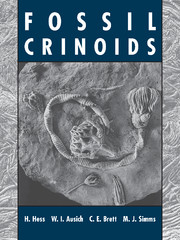Book contents
- Frontmatter
- Contents
- List of Contributors
- Acknowledgements
- Prelude
- Introduction
- GENERAL PART
- 1 Crinoid Form and Function
- 2 Systematics, Phylogeny and Evolutionary History
- 3 Fossil Occurrence
- 4 Taphonomy
- 5 Ecology and Ecological Interactions
- ASSEMBLAGES
- Appendix I Geological Time Table with Crinoid Assemblages
- Appendix II Glossary of Rocks
- Bibliography
- General Index
- Taxonomic Index
5 - Ecology and Ecological Interactions
Published online by Cambridge University Press: 10 November 2010
- Frontmatter
- Contents
- List of Contributors
- Acknowledgements
- Prelude
- Introduction
- GENERAL PART
- 1 Crinoid Form and Function
- 2 Systematics, Phylogeny and Evolutionary History
- 3 Fossil Occurrence
- 4 Taphonomy
- 5 Ecology and Ecological Interactions
- ASSEMBLAGES
- Appendix I Geological Time Table with Crinoid Assemblages
- Appendix II Glossary of Rocks
- Bibliography
- General Index
- Taxonomic Index
Summary
While marvelling at the beauty of fossils, it is easy to forget that they were once living animals. Rather than inanimate objects, when alive fossils were part of an ancient ecosystem and enmeshed in myriad biotic interactions, such as competition, predation, parasitism and commensalism. The study of this aspect of organisms is ecology (also termed palaeoecology for fossils), and ecology can be divided broadly into autecology, relating to individual organisms, and synecology, interactions among organisms.
Because ancient crinoids are known only from fossilized remains, many aspects of their ecology must be inferred from the study of living crinoids and verified by demonstrating consistency with data preserved in the geological record. For example, crinoids are exclusively marine today and can tolerate only very minor variations of marine salinity. Because fossil crinoids are found in rocks of oceanic origin and are associated with other organisms that also have a tolerance for only marine conditions, it can readily be assumed that all crinoids, ancient and living, had similar requirements. Similarly, crinoids lack specialized respiratory organs, but, unlike some echinoids and ophiuroids, they have a high oxygen demand. Consequently, crinoids are excluded from environments with low levels of oxygen; this has not limited them from spreading into a huge variety of ecological niches.
Throughout their history, crinoids have been passive suspension (or filter) feeders, so they must rely on ambient water currents for food. Crinoids never developed into either burrowing or boring habitats.
- Type
- Chapter
- Information
- Fossil Crinoids , pp. 55 - 60Publisher: Cambridge University PressPrint publication year: 1999
- 5
- Cited by



